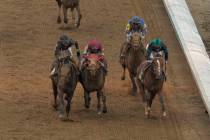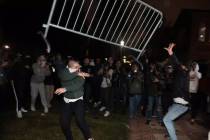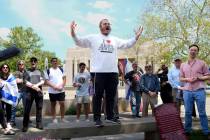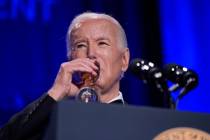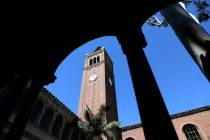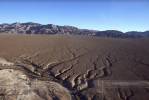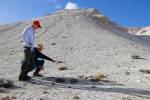Southern Nevada sees less funding for trails, parks
Through the sale of $3 billion in public land in Clark County, cities and counties throughout Nevada have built hundreds of parks and trails, pollution has been kept out of Lake Tahoe and forest fires have been prevented.
The Southern Nevada Public Land Management Act of 1998 has been a boon for the entire state. The federal program has saved taxpayers' money and made life more pleasant and safer for residents and visitors. In Clark County alone, the sales have funded 691 projects. The money paid for park and trail construction, purchases of land for open space, and making water delivery system improvements.
But the good times are about over.
Once the recession reared its ugly head in Nevada, people stopped buying U.S. Bureau of Land Management property in what had been one of the fastest-growing areas of the nation. Just five acres were sold in the most recent auction last year, and that sale brought in only $457,000. That pales in comparison with the heyday in 2004 when 10,329 acres sold for $884 million, of which Las Vegas received $248 million and Clark County $280 million.
Clark County and Las Vegas elected officials acknowledge they relied too much on the land sale revenue and now don't have other sources of money to build additional parks. But they are confident there is enough general fund revenue to repair and maintain all the parks that have been built.
"There are no guarantees anymore," said Nancy Lipski, Clark County's comprehensive planning director. "It has been a very good source of funding that allowed us to do things more quickly than normal."
what the money built
The county has used public land money to build the Wetlands Park and the Clark County Shooting Park, along with building dozens of trails as far away as Bunkerville.
Other projects funded by the land sales included construction of Centennial Hills Park, improvements at Sunset, Lorenzi and Horseman's parks, the new Red Rock Visitors Center, restoring Kiel Ranch in North Las Vegas, outdoor exhibits at the Las Vegas Springs Preserve, the Neon Museum and Boneyard, boat ramps and restrooms at Lake Mead and thinning out trees in fire-prone Carson City neighborhoods.
"SNPLMA has been good for us," said Carson City Parks and Recreation Director Roger Molendorff, noting his city also has been awarded $600,000 to purchase 400 acres along the Carson River.
Under the federal law, 5 percent of the sale prices have gone to the state's permanent school fund. That has produced $151 million over the years. Ten percent, or more than $300 million, goes to the Southern Nevada Water Authority.
The federal government has received more than $300 million for Lake Tahoe improvements such as buying environmentally sensitive land, creating fire breaks and preventing pollution from entering the alpine lake.
But the biggest share, $1.1 billion, has gone to local governments for parks and trail improvements, buying land for open space and projects to prevent forest fires.
LIMITED MONEY NOW
The BLM now restricts local governments and other participants to just two requests for funds a year. The Clark County Commission on Tuesday will approve its two requests, but they are only for a couple hundred thousand dollars. Only $8 million to $10 million in new funds will be available this year for local government, federal agencies and the state.
Funds won't dry up immediately. Clark County has not yet not received $103 million to complete already approved projects.
Under the federal law, funds go into an interest-drawing account that cannot be raided by Congress. Money flows to participants only when they receive bills for work that has been performed on their projects.
Because the BLM doesn't hand out money until it is needed, more than $300 million in interest has been collected.
Robert Wandel, the public land program manager in Las Vegas, said the BLM wants local governments to complete their approved projects by December 2014. After that, the funds will be next to nothing unless there is an unexpected demand for land.
"Ultimately we need land sales to pick up," Wandel said. "It has been an amazing program. I love seeing the good work done at Lake Tahoe."
More than 30,000 acres of public land remain available for sale in the greater Las Vegas area. In its next auction on Dec. 14, the BLM is offering only 6.5 acres.
"We used to have auctions at Cashman Field and hundreds of people would show up," said Hillerie Patton, a BLM spokeswoman in Las Vegas. "The place was packed. Later, as demand got smaller, we held them in the county building or our building. Now we offer them on the Internet."
city, county will focus on maintenance
Because of the drop in land sale funds, Las Vegas and Clark County officials say they won't be building new parks, at least not until the recession ends, and anticipate using general fund revenue to maintain existing parks.
"We just don't have the funds for new parks," Clark County Commissioner Steve Sisolak said. "It's too bad because people are using the parks more than ever. The parks are free. You can picnic or go for a walk for free, as opposed to going to the movies which can cost a family $50 or $60."
Las Vegas City Councilman Bob Coffin said Las Vegas will do its best to maintain parks with general fund revenue. He said since the population is flat, there isn't a lot of demand for new parks.
"They supplanted a lot of general fund money with SNPLMA funds to build new parks," he added. "We aren't going to have to construct any huge regional parks now."
Former U.S. Sen. Richard Bryan, D-Nev., called the SNPLMA law one of the highlights of his 12 years in Washington.
"It generated more money than anybody dreamed of," said Bryan, adding the entire congressional delegation worked for four years before passing the bill in October 1998.
Contact Capital Bureau Chief Ed Vogel at evogel@reviewjournal.com or 775-687-3901.
List of the projects by area paid for by the Southern Nevada Public Land Management Act.








